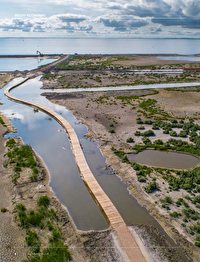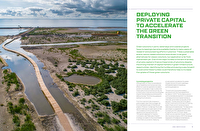A promising perspective
Although state-of-the art sustainable and nature-based solutions have proven to be effective in practice, application at scale is certainly not the case. A major hurdle is that these types of solutions almost entirely rely on direct public investment and the willingness of governmental bodies around the world to take such a step. This limits the uptake and scaling of such solutions.
From the investment side, limitations in public budgets mean there is a bigger role for private capital to play to finance such projects. Moreover, increasingly this private capital is seeking such green opportunities. This increase is driven by fiscal regimes, regulations and reputational drivers. This capital is deployed, for instance, in wind parks, solar fields, electrification of railways, but seeks further diversification in the infrastructure sector. Deploying private capital to accelerate the uptake of green solutions for ports, waterways and coastal projects is therefore a promising perspective.
This particular issue came to table in discussions with the Swiss based MAVA foundation in 2019. This foundation aims to push sustainable development in a wide sense. Leveraging the force of capital markets to make real-world impact is a key pillar of their approach. The discussion led to the idea to build an initiative around the topic of financing green infrastructure in and around ports, waterways and coastal areas. This idea quickly took shape in a cooperation between Vital Ports (a Dutch NGO dedicated to this topic), B Capital Partners AG (Swiss-based Infrastructure Investment House), Swiss Re (Re-insurance Company), IADC (International Association of Dredging Companies) and CEDA (Central Dredging Association).
Financial partners
The Swiss Re Group is one of the world’s leading providers of reinsurance, insurance and other forms of insurance-based risk transfer, working to make the world more resilient. B Capital Partners is an independent investment house established in 2003 in Zurich. They work with, and for, international institutional investors and large family offices, often in close co-operation with developers. In a broader sense, Switzerland positions itself as the world’s capital for green finance. Linking these Swiss networks to the networks of the dredging community at large therefore seemed a promising way forward.
A promising perspective however, is not something that will unfold itself to deliver its fruits, as soon became quite clear. To find the synergy, a roundtable was organised in Zurich at the Swiss Re Centre for Global Dialogue. This roundtable, with representatives of all involved organisations and their constituents, took place in February 2020 before the COVID-19 pandemic restricted travel worldwide.
The roundtable clarified a few points. The first being that the financial world and the world of dredging and engineering companies speak different languages. The financial specialists were very unfamiliar with vocabulary, project types and activities of the dredging community. And vice versa. The landscape of financial concepts, specialisations, interests and way of working was a lot to digest for the dredging community. Secondly, it was clear both communities aim for similar goals; increasing the uptake of green infrastructure projects, which is in line with the ambitions of all individual companies at the table. Thirdly, it was clear that progress can only be made when mutual understanding is further increased.
A joint study
The dialogue in Zurich asked for a practical step to gather all current understanding and knowledge about green projects and finance in a dedicated report. Such a report could be used to support further conversation with a wider variety of actors in the field. This led to the publication of the report “Financing of Sustainable Marine and Freshwater Infrastructure: A joint study to explore financing of green coastal, river and port projects”. The report is based on the findings of a broad international team of experts.
The study provides six key lessons to enhance the uptake of green investment in this sector. In a later stage, these lessons have been summarised in an infographic. In a series of webinars following the report’s publication, further learnings were gathered. This article discusses the key lessons, introduces the infographic and discusses the further reflections on the key lessons from a wider audience. Conclusions and recommendations are also provided.
Green port and waterway infrastructure
Before diving deeper into the role of private capital, it is useful to describe what is meant by green port, waterway and coastal infrastructure and how this differs from classic solutions. (Note: terms, such as green, sustainable and nature-based solutions (NbS) are used interchangeably in this article. For specifics of definitions and associated solutions, reference is made to the PIANC and EcoShape website and publications of the EC, UN and other organisations.) The collection of works at coastlines, rivers, canals and port areas are generally required to enable or provide flood protection, urban development, port development, navigable waterways and upgrade of recreational areas. Perhaps most telling is a summary of project types that describe the field. Classic examples, not necessarily green, are:
- land reclamation;
- flood barriers like dams, dykes, dunes;
- beach nourishment;
- integrated coastal zone management;
- riverbank protection;
- dredging of navigable waterways;
- port development; and
- breakwater construction.
Green variants of these assets can be seen as ranging from “more sustainable than a classic solution” up to nature-based solutions where benefits of natural processes from ecosystems help to deliver upon project needs. In general, the sustainable concepts are not only technically different, but also rely on early and extensive stakeholder involvement and execution methodologies with minimised ecological impact. Such green examples are:
- wetland restoration;
- mangrove forestry;
- coral reef restoration;
- hybrid land reclamation, including habitat improvement and expansion;
- circular use of materials, use of local materials;
- eco-friendly river protection;
- eco-friendly breakwaters;
- bird islands from dredged materials; and
- integrated river system development.
These green solutions are readily available to be applied on the precondition of a suitable financial structure. Important to mention is that all these described concepts are mature solutions and have been applied in real-world situations. For many cases, monitoring and evaluations took place and showed the effectiveness both in terms of services provided as well as ecological quality.
Financing projects
In short, financing means that capital is provided to develop a project where the capital provider expects, in time, to receive or earn back this capital including some interest or profit. However, the majority of marine and freshwater infrastructure projects are traditionally funded by the public sector (i.e. with taxpayers’ money), without involving financing. The responsible public agency will pay for project development expenses directly in accordance with the contractual arrangement with the developer/contractor. In contrast, financed projects have a capital provider covering the costs of development with a payback mechanism kicking in after completion of the project. Two different types of financed projects can be distinguished on the basis of the cashflow for interest payments and loan repayments. These broadly fall into two categories based on the origin of those cashflows:
- Public service projects (e.g. coastal protection): The government, as project client, pays periodically after completion, where the payments may be based on performance or availability criteria (Figure 1).
- Commercial projects (e.g. private port development): The users or beneficiaries pay for the project’s results or services. Cashflow is generated based on the project’s business model (Figure 2).
Figure 1 and 2 show graphically how these two types of financing differ. In practice, a wide spectrum of variants and combinations can be used, sometimes referred to under the title of “blended finance”.














